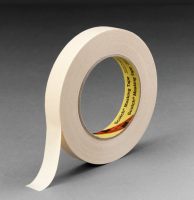








Masking tape is a type of pressure-sensitive tape made of a thin and easy-to-tear paper, and an easily released pressure-sensitive adhesive. It is available in a variety of widths. It is used mainly in painting, to mask off areas that should not be painted. The adhesive is the key element to its usefulness, as it allows the tape to be easily removed without leaving residue or damaging the surface to which it is applied. The tape is available in several strengths, rated on a 1–100 scale based on the strength of the adhesive. Most painting operations will require a tape in the 50 range. Household masking tape is made of an even weaker paper and lower-grade adhesive.
History
Masking tape was invented in 1925 by 3M employee Richard Drew.Drew observed auto-body workers growing frustrated when they removed butcher paper they had taped to cars they were painting. The strong adhesive on the tape peeled off some of the paint they had just applied. Touching up the damaged areas increased their costs. Drew realized the need for tape with a gentler adhesive.
Usage
For its original use of marking off areas where body paint is not desired, a special grade of painter's masking tape is needed. With this special grade, very clean lines can be produced. Without it, the paint bleeds under the edges of the tape, producing a fuzzy or varied line.
Drafting tape looks similar to ordinary household masking tape, but has a lower tack. It is intended to hold blueprints to a drawing board or light table, and to pull off easily without damaging the drawing.
House painter's tape is rated by how many days it can be left up without leaving residue on the surface being masked. It is available in 1, 3, 7, 14, 30, and 60-day ratings, with the 7- and 14-day tapes being the most common. The longer-rated tapes are typically less adhesive, and are sold for use on smooth, delicate surfaces such as vinyl wallpaper and recently painted walls. Painter's (decorator's) tape in the U.S is most often the blue variety or sometimes purple in color as opposed to the tan or off white household masking tape. Spraying WD-40 is a popular way to remove any sticky residue.
Masking tape is also used in long strips on larger glass panes in situations where the glass might be shattered, harming those in the vicinity.